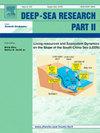A data-assimilative modeling investigation of Gulf Stream variability
Abstract
An advanced data-assimilative ocean circulation model is used to investigate Gulf Stream (GS) variability during 2017–2018. The modeling system applies a strong-constraint, 4D variational data assimilation algorithm. It assimilates satellite-based sea surface height and sea surface temperature measurements and in situ temperature and salinity profiles. Model skill assessment metrics along with comparisons of GS position and GS's three-dimensional mean kinetic energy with historical observations are applied to validate the data-assimilative model. The resulting time- and space-continuous ocean state estimates are used to diagnose eddy kinetic energy conversion and cross-stream eddy heat and salt fluxes over the two-year study period. The processes leading to kinetic energy conversion are primarily due to GS meanders. Significant inverse energy cascading (EKE→MKE and EKE→EPE) can occur during GS-eddy interactions, particularly during onshore intrusions or offshore meanderings of the GS. Throughout the two-year study period, the cross-stream eddy heat and salt fluxes off Cape Hatteras were predominantly positive (onshore). Both GS offshore meandering (occurring 44% of the time and associated with shelf/slope water export) and GS intrusion (occurring 56% of the time) contribute to onshore heat and salt transport. Improved understanding of these processes and dynamics requires strong integration of an advanced observational infrastructure that combines remote sensing; fixed, mobile, and shore-based observing components; and high-resolution data assimilative models.

 求助内容:
求助内容: 应助结果提醒方式:
应助结果提醒方式:


